ignition Lancia Delta 2010 Owner handbook (in English)
[x] Cancel search | Manufacturer: LANCIA, Model Year: 2010, Model line: Delta, Model: Lancia Delta 2010Pages: 276, PDF Size: 5.31 MB
Page 88 of 276

GETTING TO KNOW YOUR CAR87
1
Anti-pinch safety device
The vehicle is equipped with an anti-pinch safety device
for the upwards motion of the windows.
This safety system is capable of recognizing the presence
of an obstacle whilst the window is closing; when this hap-
pens, the system stops the travel of the glass and, de-
pending on the position of the window, reverses its move-
ment.
This device is also useful when the windows are activat-
ed accidentally by children on board the vehicle.
The anti-pinch function is active both during manual and
automatic operation of the electric windows. Following
the intervention of the anti-pinch system, the window trav-
el is immediately interrupted and subsequently reversed
until the lower end of travel is reached. During this time
the window cannot be operated in any way.IMPORTANT If the anti-pinch protection intervenes 5
times consecutively within 1 minute or a system failure
is detected, the automatic window closing function is in-
hibited. The window can then only be operated in steps of
half a second and the button must be released following
each step.
One of the following manoeuvres must be carried out in
order to restore correct operation:
❍switch off and restart the engine;
❍fully lower the window concerned.
IMPORTANT With ignition key at STOP or removed, the
electric windows remain active for about 3 minutes and
are deactivated the moment a door is opened.
001-142 Delta 3ed gb 30-11-2009 11:22 Pagina 87
Page 99 of 276
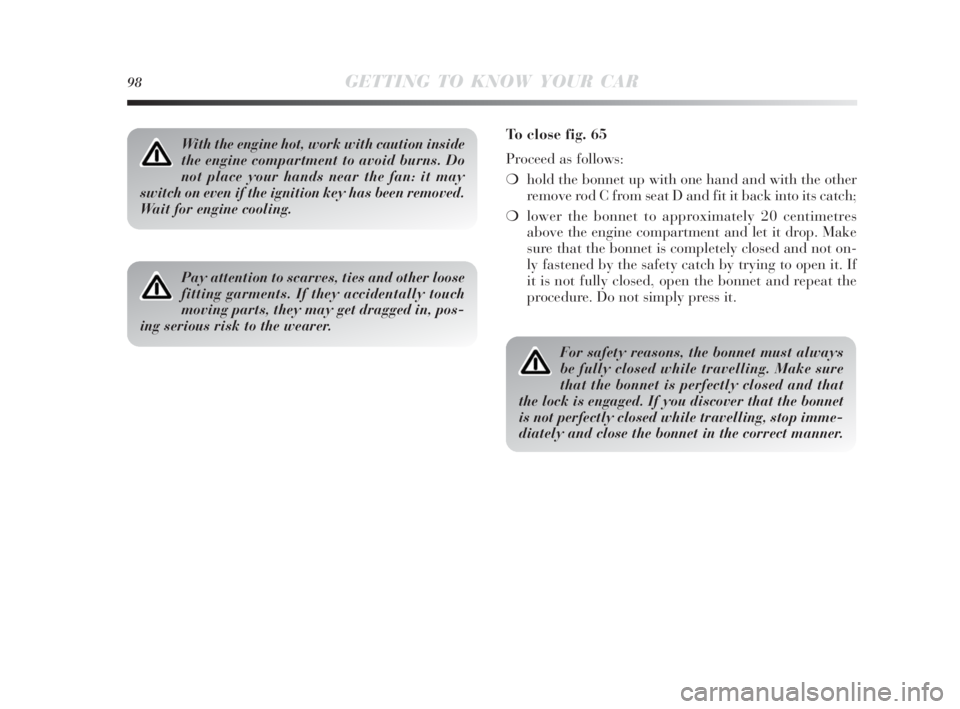
98GETTING TO KNOW YOUR CAR
With the engine hot, work with caution inside
the engine compartment to avoid burns. Do
not place your hands near the fan: it may
switch on even if the ignition key has been removed.
Wait for engine cooling.
Pay attention to scarves, ties and other loose
fitting garments. If they accidentally touch
moving parts, they may get dragged in, pos-
ing serious risk to the wearer.
To close fig. 65
Proceed as follows:
❍hold the bonnet up with one hand and with the other
remove rod C from seat D and fit it back into its catch;
❍lower the bonnet to approximately 20 centimetres
above the engine compartment and let it drop. Make
sure that the bonnet is completely closed and not on-
ly fastened by the safety catch by trying to open it. If
it is not fully closed, open the bonnet and repeat the
procedure. Do not simply press it.
For safety reasons, the bonnet must always
be fully closed while travelling. Make sure
that the bonnet is perfectly closed and that
the lock is engaged. If you discover that the bonnet
is not perfectly closed while travelling, stop imme-
diately and close the bonnet in the correct manner.
001-142 Delta 3ed gb 30-11-2009 11:22 Pagina 98
Page 101 of 276
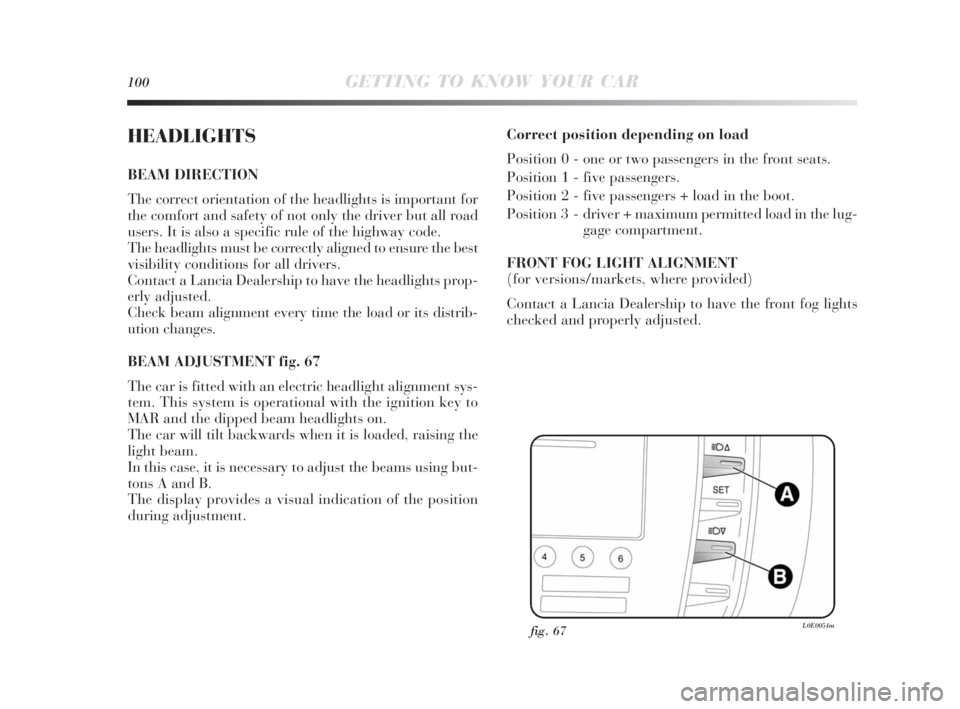
100GETTING TO KNOW YOUR CAR
HEADLIGHTS
BEAM DIRECTION
The correct orientation of the headlights is important for
the comfort and safety of not only the driver but all road
users. It is also a specific rule of the highway code.
The headlights must be correctly aligned to ensure the best
visibility conditions for all drivers.
Contact a Lancia Dealership to have the headlights prop-
erly adjusted.
Check beam alignment every time the load or its distrib-
ution changes.
BEAM ADJUSTMENT fig. 67
The car is fitted with an electric headlight alignment sys-
tem. This system is operational with the ignition key to
MAR and the dipped beam headlights on.
The car will tilt backwards when it is loaded, raising the
light beam.
In this case, it is necessary to adjust the beams using but-
tons A and B.
The display provides a visual indication of the position
during adjustment.Correct position depending on load
Position 0 - one or two passengers in the front seats.
Position 1 - five passengers.
Position 2 - five passengers + load in the boot.
Position 3 - driver + maximum permitted load in the lug-
gage compartment.
FRONT FOG LIGHT ALIGNMENT
(for versions/markets, where provided)
Contact a Lancia Dealership to have the front fog lights
checked and properly adjusted.
fig. 67L0E0054m
001-142 Delta 3ed gb 30-11-2009 11:22 Pagina 100
Page 104 of 276
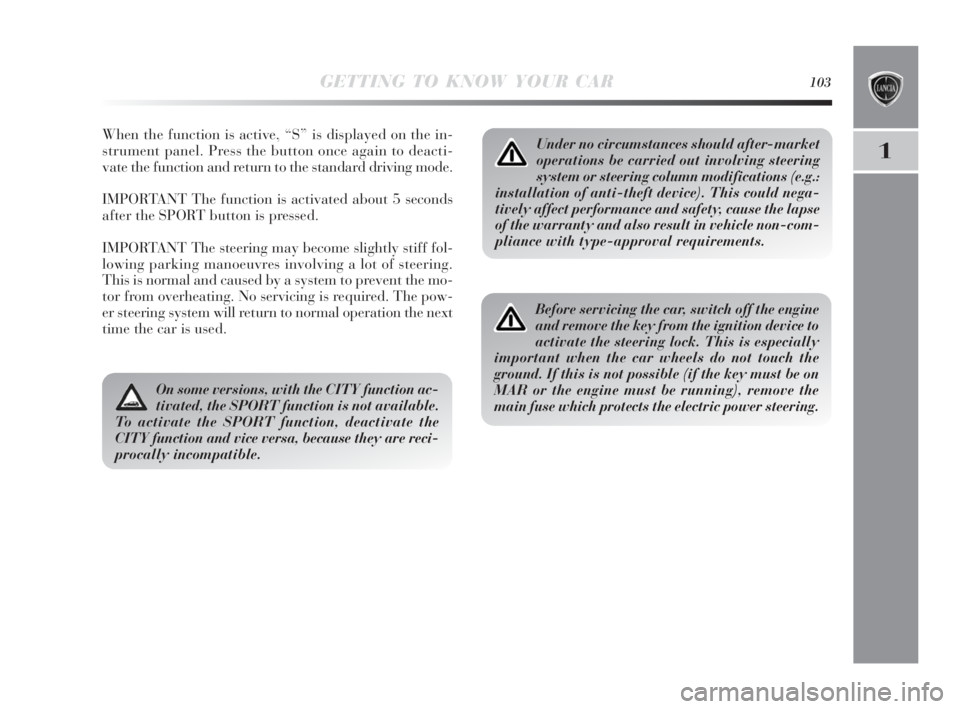
GETTING TO KNOW YOUR CAR103
1
When the function is active, “S” is displayed on the in-
strument panel. Press the button once again to deacti-
vate the function and return to the standard driving mode.
IMPORTANT The function is activated about 5 seconds
after the SPORT button is pressed.
IMPORTANT The steering may become slightly stiff fol-
lowing parking manoeuvres involving a lot of steering.
This is normal and caused by a system to prevent the mo-
tor from overheating. No servicing is required. The pow-
er steering system will return to normal operation the next
time the car is used.Under no circumstances should after-market
operations be carried out involving steering
system or steering column modifications (e.g.:
installation of anti-theft device). This could nega-
tively affect performance and safety, cause the lapse
of the warranty and also result in vehicle non-com-
pliance with type-approval requirements.
Before servicing the car, switch off the engine
and remove the key from the ignition device to
activate the steering lock. This is especially
important when the car wheels do not touch the
ground. If this is not possible (if the key must be on
MAR or the engine must be running), remove the
main fuse which protects the electric power steering.
On some versions, with the CITY function ac-
tivated, the SPORT function is not available.
To activate the SPORT function, deactivate the
CITY function and vice versa, because they are reci-
procally incompatible.
001-142 Delta 3ed gb 30-11-2009 11:22 Pagina 103
Page 116 of 276

GETTING TO KNOW YOUR CAR115
1
EOBD SYSTEM
The EOBD system (European On Board Diagnosis) pro-
vides a continuous diagnosis of the emission-related com-
ponents. It also alerts the driver, by turning on the
U
warning light on the instrument panel together with a mes-
sage on the reconfigurable multifunctional display, when
these components are no longer in peak condition (see “In-
strument panel warning lights”).
The objective is:
❍to keep system efficiency under control;
❍to signal a fault which causes emission levels to in-
crease;
❍to signal the need to replace deteriorated components.
The system also has a diagnostic connector that can be in-
terfaced with appropriate tools, which makes it possible
to read the error codes stored in the control unit together
with a series of specific parameters for engine operation
and diagnosis.
This check can also be carried out by the traffic police.
IMPORTANT After eliminating the problem, to check the
system completely, Lancia Dealerships are obliged to run
a bench test and, if necessary, road tests which may also
call for a long journey.
Go to a Lancia Dealership as soon as pos-
sible if warning light
Ueither does not light
up when the key is turned to MAR or if,
while travelling, the warning light comes on either
steadily or blinking (along with a message on the
reconfigurable multifunctional display). The op-
eration of warning light
Umay be checked by the
traffic police using specific devices. Respect the
laws in force in the country where you are driving.
“DUALDRIVE” ELECTRIC POWER
STEERING SYSTEM
This is an electrically controlled power steering system
called “Dualdrive”. It is only operational with the ignition
key turned to MAR and the engine running; it can be cus-
tomised by the driver according to the driving conditions.
IMPORTANT If the ignition key is turned very quickly,
it may take 1-2 seconds before full power steering func-
tionality can be achieved.
001-142 Delta 3ed gb 30-11-2009 11:22 Pagina 115
Page 118 of 276
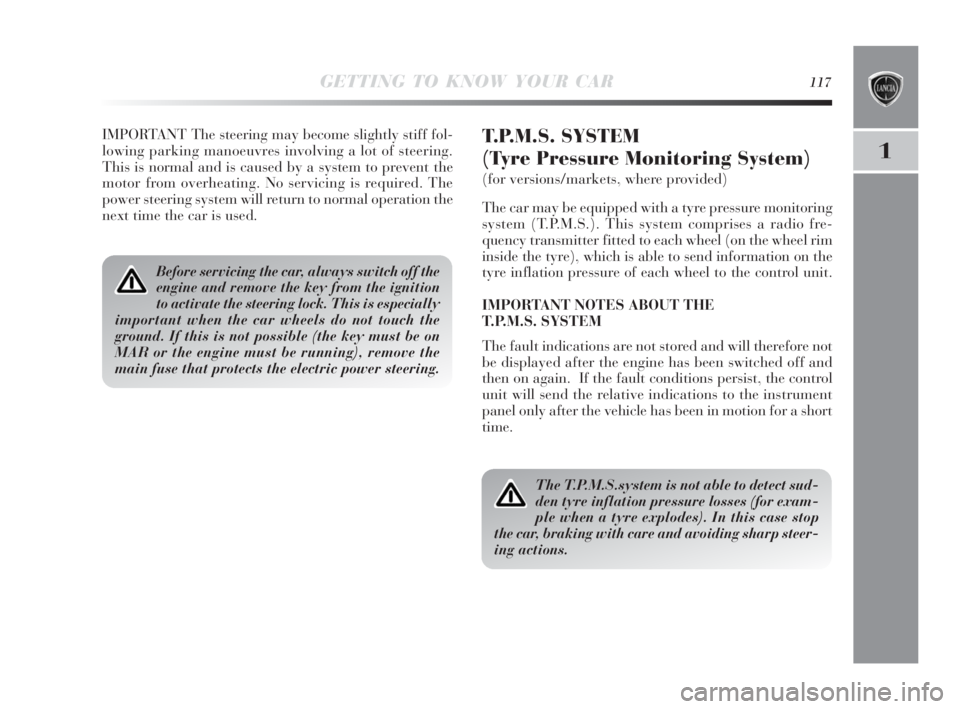
GETTING TO KNOW YOUR CAR117
1
IMPORTANT The steering may become slightly stiff fol-
lowing parking manoeuvres involving a lot of steering.
This is normal and is caused by a system to prevent the
motor from overheating. No servicing is required. The
power steering system will return to normal operation the
next time the car is used.T.P.M.S. SYSTEM
(Tyre Pressure Monitoring System)
(for versions/markets, where provided)
The car may be equipped with a tyre pressure monitoring
system (T.P.M.S.). This system comprises a radio fre-
quency transmitter fitted to each wheel (on the wheel rim
inside the tyre), which is able to send information on the
tyre inflation pressure of each wheel to the control unit.
IMPORTANT NOTES ABOUT THE
T.P.M.S. SYSTEM
The fault indications are not stored and will therefore not
be displayed after the engine has been switched off and
then on again. If the fault conditions persist, the control
unit will send the relative indications to the instrument
panel only after the vehicle has been in motion for a short
time.
Before servicing the car, always switch off the
engine and remove the key from the ignition
to activate the steering lock. This is especially
important when the car wheels do not touch the
ground. If this is not possible (the key must be on
MAR or the engine must be running), remove the
main fuse that protects the electric power steering.
The T.P.M.S.system is not able to detect sud-
den tyre inflation pressure losses (for exam-
ple when a tyre explodes). In this case stop
the car, braking with care and avoiding sharp steer-
ing actions.
001-142 Delta 3ed gb 30-11-2009 11:22 Pagina 117
Page 165 of 276

164SAFETY
With ignition key inserted and turned to
MAR, the air bags can activate even if the en-
gine is off and the car is at a standstill, if it
is hit by another vehicle. For this reason, children
must never sit on the front seat, even if the car is not
moving. We remind you that if the key is inserted
and turned to STOP, no safety device (air bag or
pretensioner) activates following a collision; non-
deployment in such cases is consequently not the
sign of a fault.
When the key is turned to MAR, the warn-
ing light “turns on, blinking for a few sec-
onds, to remind you that the passenger air
bag will activate in the event of a collision, then it
turns off.
Do not wash the seats with pressurized wa-
ter or steam (manually or at the automatic
washing stations).
The front airbags deploy in the event of more
severe collisions than those required for de-
ploying the pretensioners. For collisions in
the range between the two activation thresholds,
pretensioner activation is normal.
Do not hook rigid objects to clothes hangers
and support handles.
The airbag does not replace the seat belts, it
increases their effectiveness. Furthermore,
since front airbags are not deployed in low
speed collisions, side collisions, rear-end shunts
or roll-overs, the passengers are only protected by
the seat belts which must be fastened at all times.
143-164 Delta 4ed gb 12-02-2010 10:20 Pagina 164
Page 168 of 276

STARTING UP AND DRIVING167
3
STARTING PROCEDURE FOR PETROL
VERSIONS
Proceed as follows:
❍engage the handbrake;
❍put the gear lever into neutral;
❍press the clutch pedal down to the floor without touch-
ing the accelerator;
❍turn the ignition key to AVV and release it the moment
the engine starts.
If the engine does not start at the first attempt, return
the ignition key to STOP before repeating the procedure.
If, when the ignition key is at MAR the
Ywarning light
remains lit together with warning light U, turn the key
to STOP and then back to MAR; if the warning light re-
mains lit, try with the other keys provided with the car.
Contact a Lancia Dealership if you still cannot start the
engine.
PROCEDURE FOR DIESEL VERSIONS
Proceed as follows:
❍engage the handbrake;
❍put the gear lever into neutral;
❍turn the ignition key to MAR: instrument panel warn-
ing lights
mandYwill light up;
❍wait for warning lights
Yandm, to turn off. The
hotter the engine is, the quicker this will happen;❍press the clutch pedal down to the floor without touch-
ing the accelerator;
❍turn the ignition key to AVV as soon as the
mwarn-
ing light goes out. Waiting too long will waste the work
done by the glow plugs.
Release the key as soon as the engine starts.
IMPORTANT When the engine is cold, the accelerator
pedal must be completely released when the key is turned
to AVV.
If the engine does not start at the first attempt, return the
ignition key to STOP before repeating the procedure. If,
when the ignition key is at MAR the
Ywarning light re-
mains lit, turn the key to STOP and then back to MAR; if
the warning light remains lit, try with the other keys pro-
vided with the car. Contact a Lancia Dealership if you still
cannot start the engine.
Warning light mwill blink for 60 seconds
after starting or during prolonged cranking
to indicate a fault in the glow plug preheat-
ing system. Use the car normally if the engine starts
and contact the Lancia Dealership as soon as pos-
sible.
165-174 Delta 3ed gb 11-11-2009 12:10 Pagina 167
Page 169 of 276
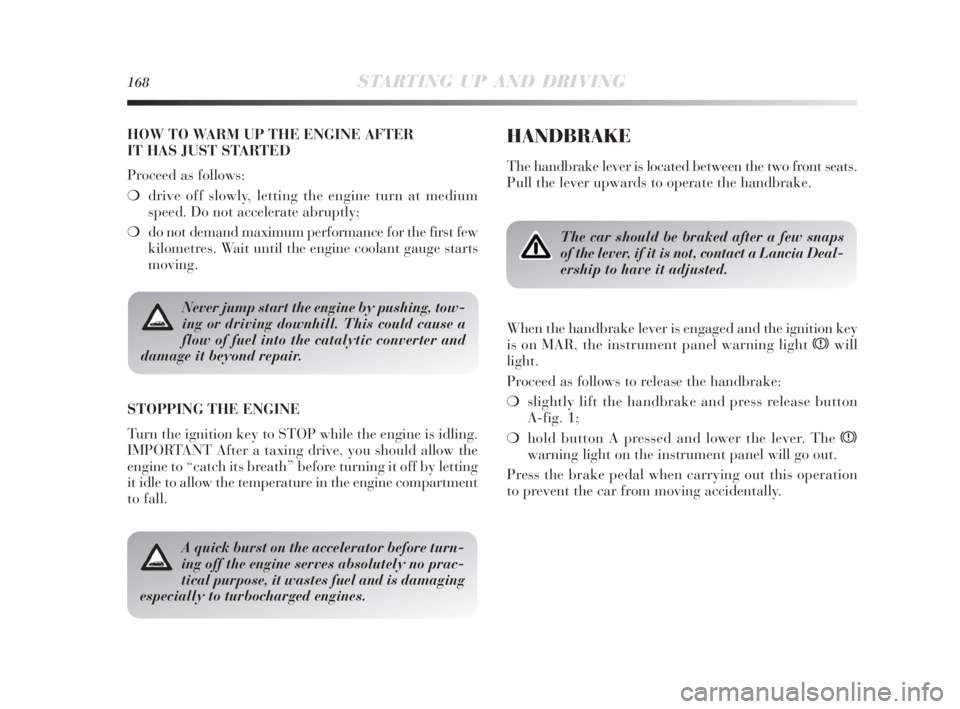
168STARTING UP AND DRIVING
Never jump start the engine by pushing, tow-
ing or driving downhill. This could cause a
flow of fuel into the catalytic converter and
damage it beyond repair.
HOW TO WARM UP THE ENGINE AFTER
IT HAS JUST STARTED
Proceed as follows:
❍drive off slowly, letting the engine turn at medium
speed. Do not accelerate abruptly;
❍do not demand maximum performance for the first few
kilometres. Wait until the engine coolant gauge starts
moving.
STOPPING THE ENGINE
Turn the ignition key to STOP while the engine is idling.
IMPORTANT After a taxing drive, you should allow the
engine to “catch its breath” before turning it off by letting
it idle to allow the temperature in the engine compartment
to fall.
A quick burst on the accelerator before turn-
ing off the engine serves absolutely no prac-
tical purpose, it wastes fuel and is damaging
especially to turbocharged engines.
HANDBRAKE
The handbrake lever is located between the two front seats.
Pull the lever upwards to operate the handbrake.
The car should be braked after a few snaps
of the lever, if it is not, contact a Lancia Deal-
ership to have it adjusted.
When the handbrake lever is engaged and the ignition key
is on MAR, the instrument panel warning light xwill
light.
Proceed as follows to release the handbrake:
❍slightly lift the handbrake and press release button
A-fig. 1;
❍hold button A pressed and lower the lever. The x
warning light on the instrument panel will go out.
Press the brake pedal when carrying out this operation
to prevent the car from moving accidentally.
165-174 Delta 3ed gb 11-11-2009 12:10 Pagina 168
Page 170 of 276

STARTING UP AND DRIVING169
3
PARKING THE CAR
Proceed as follows:
❍stop the engine and engage the handbrake;
❍engage a gear (on a slope, engage first gear if the car
is faced uphill or reverse if it is faced downhill) and
leave the wheels steered.
If the car is parked on a steep slope, it is further advisable
to block the wheels with a wedge or stone.
Do not leave the ignition key on MAR to prevent drain-
ing the battery. Always remove the key when you leave the
car.
Never leave children unattended in the car. Always remove
the ignition key when leaving the car and take it out with
you.
fig. 1L0E0072m
USING THE MANUAL GEARBOX
To engage the gears, press the clutch pedal fully and shift
the gear lever into one of the required positions (the gear
diagram varies according to the different versions and is
shown on the knob or on the plate below the lever fig. 2).
To engage sixth gear, operate the lever by pressing it to-
wards the right in order to avoid engaging fourth gear by
mistake. Use the same action to pass from sixth to fifth
gear.
IMPORTANT Reverse may only be engaged when the car
is at a standstill. With the engine running, wait at least 2
seconds before engaging reverse gear with the clutch
pressed down to the floor in order to avoid damaging or
scraping the gears.
fig. 2L0E0073m
165-174 Delta 3ed gb 11-11-2009 12:10 Pagina 169